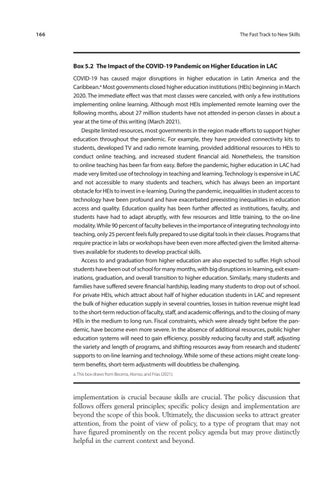166
The Fast Track to New Skills
Box 5.2 The Impact of the COVID-19 Pandemic on Higher Education in LAC COVID-19 has caused major disruptions in higher education in Latin America and the Caribbean.a Most governments closed higher education institutions (HEIs) beginning in March 2020. The immediate effect was that most classes were canceled, with only a few institutions implementing online learning. Although most HEIs implemented remote learning over the following months, about 27 million students have not attended in-person classes in about a year at the time of this writing (March 2021). Despite limited resources, most governments in the region made efforts to support higher education throughout the pandemic. For example, they have provided connectivity kits to students, developed TV and radio remote learning, provided additional resources to HEIs to conduct online teaching, and increased student financial aid. Nonetheless, the transition to online teaching has been far from easy. Before the pandemic, higher education in LAC had made very limited use of technology in teaching and learning. Technology is expensive in LAC and not accessible to many students and teachers, which has always been an important obstacle for HEIs to invest in e-learning. During the pandemic, inequalities in student access to technology have been profound and have exacerbated preexisting inequalities in education access and quality. Education quality has been further affected as institutions, faculty, and students have had to adapt abruptly, with few resources and little training, to the on-line modality. While 90 percent of faculty believes in the importance of integrating technology into teaching, only 25 percent feels fully prepared to use digital tools in their classes. Programs that require practice in labs or workshops have been even more affected given the limited alternatives available for students to develop practical skills. Access to and graduation from higher education are also expected to suffer. High school students have been out of school for many months, with big disruptions in learning, exit examinations, graduation, and overall transition to higher education. Similarly, many students and families have suffered severe financial hardship, leading many students to drop out of school. For private HEIs, which attract about half of higher education students in LAC and represent the bulk of higher education supply in several countries, losses in tuition revenue might lead to the short-term reduction of faculty, staff, and academic offerings, and to the closing of many HEIs in the medium to long run. Fiscal constraints, which were already tight before the pandemic, have become even more severe. In the absence of additional resources, public higher education systems will need to gain efficiency, possibly reducing faculty and staff, adjusting the variety and length of programs, and shifting resources away from research and students’ supports to on-line learning and technology. While some of these actions might create longterm benefits, short-term adjustments will doubtless be challenging. a. This box draws from Becerra, Alonso, and Frias (2021).
implementation is crucial because skills are crucial. The policy discussion that follows offers general principles; specific policy design and implementation are beyond the scope of this book. Ultimately, the discussion seeks to attract greater attention, from the point of view of policy, to a type of program that may not have figured prominently on the recent policy agenda but may prove distinctly helpful in the current context and beyond.

